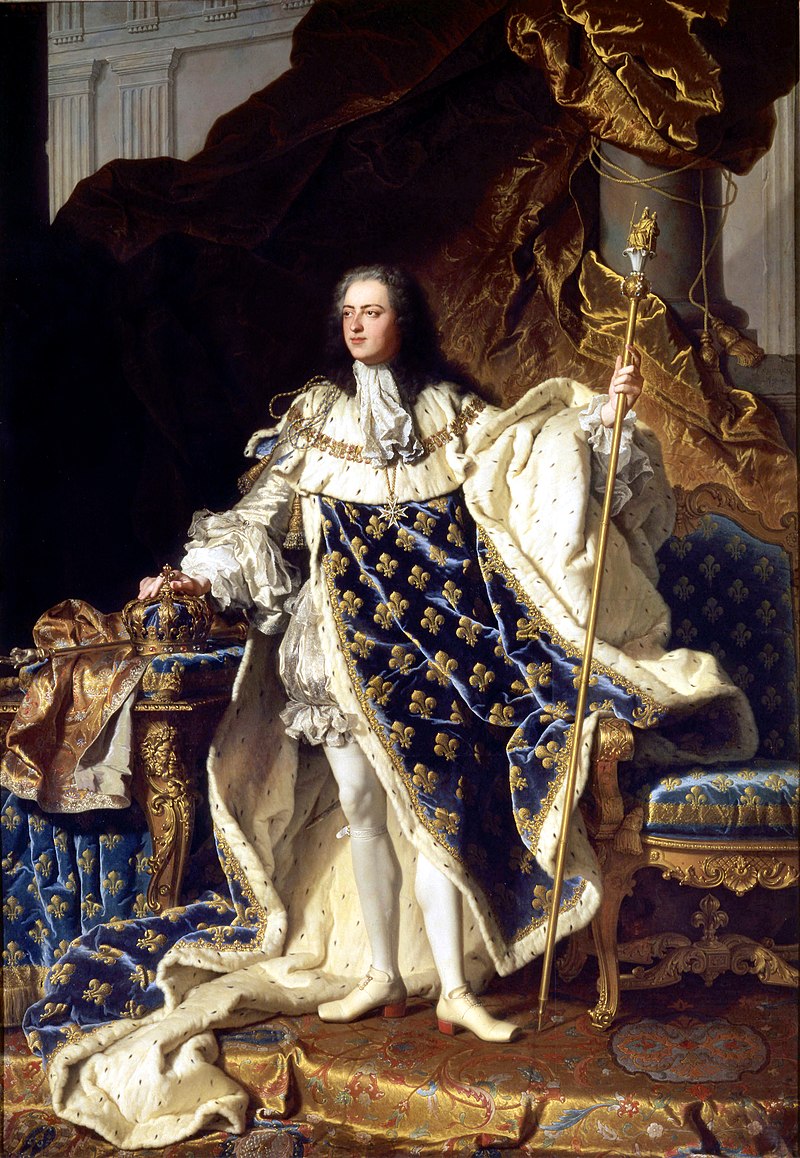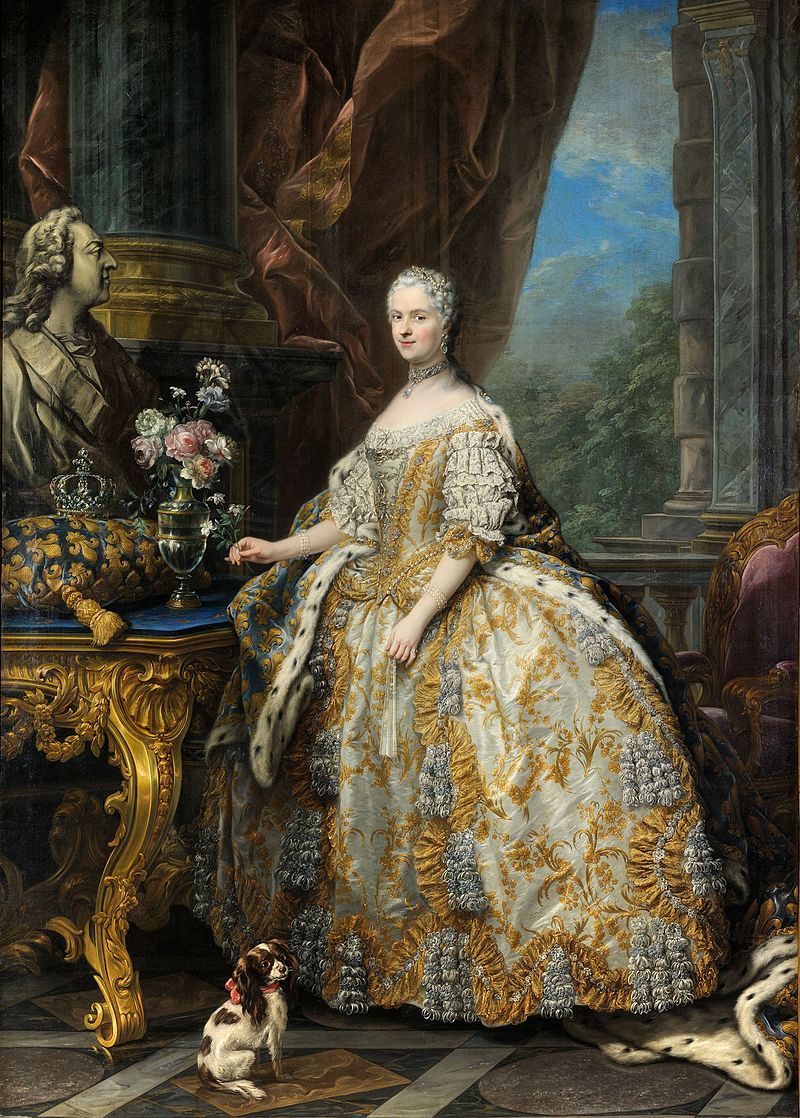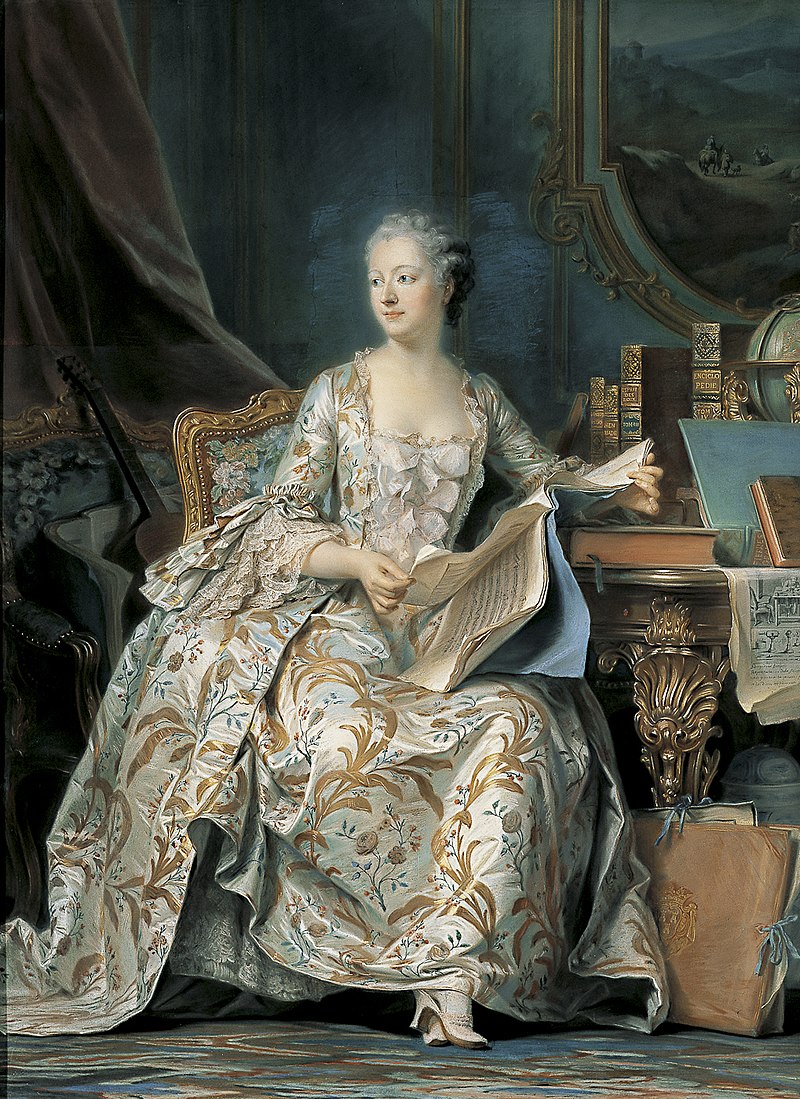by Scott Mehl © Unofficial Royalty 2016

King Louis XV, painted by Hyacinthe Rigaud. source: Wikipedia
King Louis XV of France
Louis XV reigned as King of France from 1715 until 1774, succeeding his great-grandfather, King Louis XIV. He was born on February 15, 1710, at the Palace of Versailles in Versailles, France, the third son of Prince Louis, Duke of Burgundy, and Princess Marie Adélaïde of Savoy. At birth, he was created Duke of Anjou. Louis had two older brothers, both also named Louis:
Louis had two older brothers, both also named Louis:
- Louis, Duke of Brittany (1704 – 1705), died from convulsions
- Louis, Duke of Brittany (1707 – 1712), died from measles
Shortly after his birth, his grandfather died suddenly, and his father became the direct heir to the throne. The following year, in February 1712, Louis’s mother died of measles. Within days Louis’s father also succumbed to the illness, and both Louis and his surviving brother were also infected. On February 8, 1712, his elder brother died, and Louis became the Dauphin – heir to the throne.
Three years later, on September 1, 1715, King Louis XIV died, and the young Louis took the throne as King Louis XV. His great-grandfather had stipulated in his will that a Regency Council be established until Louis reached his majority. The Regency Council was led by King Louis XIV’s nephew, Philippe, Duke of Orléans, and included several of the late King’s legitimized sons.
Louis was raised by a governess, Madame de Ventadour, splitting his time between the Château of Vincennes, and the Tuileries Palace. His education was overseen by the Duke of Maine, one of his great-grandfather’s legitimized sons. Louis was placed in the care of François de Villeroy, an old friend of King Louis XIV, and was tutored by André-Hercule de Fleury (later Cardinal de Fleury). An avid student, the young King developed a wide variety of interests, particularly in science.

King Louis XV and Infanta Mariana Victoria of Spain, painted by Alexis Simon Belle. source: Wikipedia
In 1721, Louis was betrothed to his first cousin, Infanta Mariana Victoria of Spain, who was just 3-years-old at the time. She was the daughter of Louis’s uncle, King Felipe V of Spain, and Elisabeth Farnese of Parma. However, Louis showed little interest in his young cousin or the prospect of marrying her. The marriage was later called off, and the young Spanish Infanta returned to Spain. She would later become Queen of Portugal as the wife of King José I.

King Louis XV in his coronation robes, painted by Hyacinthe Rigaud. source: Wikipedia
In 1722, Louis returned the court to the Palace of Versailles where it would remain through his reign. In October of that year, he was crowned at Reims Cathedral. Following his majority in February 1723, Louis retained the Duke of Orléans as his first minister, and upon his death, appointed his cousin, Louis Henri, Duke of Bourbon. Bourbon, concerned that the King was not in the best of health, and fearing that the House of Orléans would try and take the throne should the King die, began searching for an appropriate bride for the King – preferably one who was old enough to bear children.

Maria Leszczyńska as Queen of France, painted by Carle van Loo. source: Wikipedia
Before long, the search was narrowed and a bride was selected. Maria Leszczyńska was the daughter of the deposed King Stanisław I of Poland. Although poor and considered rather plain-looking, Maria was determined to be the best choice, primarily because of her lack of alliance with any of the people involved in finding the King a wife. And the fact that she was Catholic and old enough to bear children immediately made the decision final. The couple was engaged on April 2, 1725, and married by proxy at the Cathedral of Strasbourg on August 15. Several weeks later, the couple’s wedding took place at the Château de Fontainebleau on September 5, 1725, having only met in person for the first time the night before. Initially a love match, the couple enjoyed a happy marriage for several years, and had ten children:
- Louise Élisabeth (1727 – 1759), married Infante Felipe of Spain, Duke of Parma, founder of the House of Bourbon-Parma, had issue, died of smallpox
- Anne Henriette (1727 – 1752), unmarried, died of smallpox
- Marie-Louise (1728 – 1733), died in childhood
- Louis, Dauphin of France (1729 – 1765), married (1) Infanta Maria Teresa Rafaela of Spain, had issue; (2) Maria Josepha of Saxony, had issue
- Philippe of France, Duke of Anjou (1730 – 1733), died in childhood
- Marie Adélaïde (1732 – 1800), unmarried
- Victoire Louise Marie Thérèse (1733 – 1799), unmarried
- Sophie Philippine Élisabeth Justine (1734 – 1782), unmarried
- Marie Thérèse Félicité (1736 – 1744), died in childhood of smallpox
- Louise Marie (1737 – 1787), became a nun, beatified in 1873, and known as Blessed Thérèse of Saint Augustine

Madame de Pompadour, painted by Maurice de La Tour. source: Wikipedia
Louis soon began to take mistresses – beginning with Diane Adélaïde de Mailly, the first of four de Mailly sisters who would enjoy the King’s affections. Then, in February 1745, the King met Jeanne-Antoinette Poisson at a ball given in honor of the marriage of the Dauphin. Poisson, who would later become Marquise de Pompadour, was perhaps the King’s most famous mistress. Within weeks of meeting, she became the King’s chief mistress and was given apartments at the Palace of Versailles. The King created her Marquise de Pompadour, as she could not be presented at court without holding a title. Until her death, she remained one of the King’s closest friends and confidantes and had significant power within the court. Of all of the King’s mistresses, Madame de Pompadour was the only one who maintained a respectful relationship with the Queen, to whom she later served as a lady-in-waiting. Despite ending their romantic relationship in the early 1750s, she and the King remained devotedly close until her death in 1764.

Madame du Barry, painted by Élisabeth Vigée Le Brun. source: Wikipedia
The King’s last chief mistress was Jeanne Bécu, comtesse du Barry, who first met the King in 1768. After being formally presented at court in 1769, Madame du Barry remained with the King until his death. Her extravagance would later help contribute to the downfall of the French monarchy. King Louis was truly infatuated with his much younger lover, and lavished her with gifts, including many priceless jewels. In 1772, he commissioned a jeweler to create a diamond necklace that would be grander than any other. Although the King died before the necklace was finished, it would later become the focus of a huge scandal in which Queen Marie Antoinette would be falsely accused. See Wikipedia: The Affair of the Diamond Necklace.

King Louis XV, painted by Louis-Michel van Loo. source: Wikipedia
Just a few years after taking the throne, with economic and social discord in France caused by the Duke of Bourbon’s policies, the King dismissed him in 1726 and replaced him with Cardinal Fleury. Fleury’s leadership brought about perhaps the most prosperous years of the King’s reign. With the support of the King, Fleury stabilized and greatly expanded the French economy. Highways were built connecting the most remote parts of the country, and trade was greatly increased throughout the world. Peace was sought with England and Spain – aided greatly by the birth of a male heir in 1729 which eliminated any succession crisis.
However, the King often deviated from Fleury’s policies. He intervened in the War of the Polish Succession, hoping to help restore his father-in-law to the Polish throne and to try and gain control of the Duchy of Lorraine. While he was unsuccessful in helping his father-in-law, he was able to take Lorraine. (Under the terms of the Treaty of Vienna in 1738, the duchy was granted to the former King Stanisław, with the condition that it would eventually pass to King Louis.)
King Louis XV’s reign saw France’s entry in The War of the Austrian Succession in 1740, with France gaining significant amounts of territory. However, at the Treaty of Aix-la-Chapelle in 1748, Louis returned the lands back to their rightful owners. For this, he was greatly praised throughout Europe but became very unpopular within his own country. Just a few years later, the King would find France at war with Great Britain in the French and Indian War and soon pulled into the Seven Years’ War.
The King was a victim of an assassination attempt in 1757. While walking to his carriage in the Marble Courtyard at the Palace of Versailles, Robert-François Damiens stabbed the king with a small knife. Fortunately, it was a relatively minor wound and the King survived.
King Louis XV died of smallpox at the Palace of Versailles on May 10, 1774, and was buried at the Basilica of Saint-Denis in Paris. He was succeeded by his grandson, King Louis XVI.
This article is the intellectual property of Unofficial Royalty and is NOT TO BE COPIED, EDITED, OR POSTED IN ANY FORM ON ANOTHER WEBSITE under any circumstances. It is permissible to use a link that directs to Unofficial Royalty.
France Resources at Unofficial Royalty
